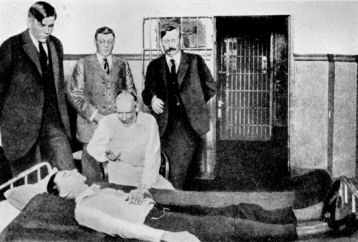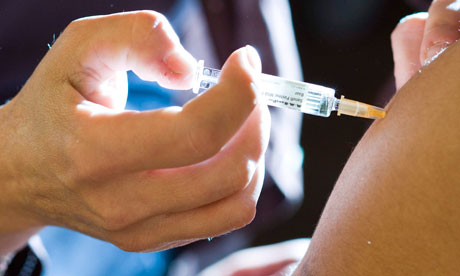 The process by which sodium pentothal came to be used to obtain confessions of guilt was a circuitous one. The particular compound was invented in 1934 by Ernest H. Volwiler and Donalee L. Tabern, both of whom were trying to invent another pain killer. Although it did relax a patient, and enough of it knocked a person out, sodium pentothal didn't kill pain as much as they had hoped. It wasn't ideal for surgeons, but it came to be used by shrinks. Psychiatrists during the World Wars saw some soldiers with acute shell shock who either had great difficulty speaking or were unable to speak at all.
The process by which sodium pentothal came to be used to obtain confessions of guilt was a circuitous one. The particular compound was invented in 1934 by Ernest H. Volwiler and Donalee L. Tabern, both of whom were trying to invent another pain killer. Although it did relax a patient, and enough of it knocked a person out, sodium pentothal didn't kill pain as much as they had hoped. It wasn't ideal for surgeons, but it came to be used by shrinks. Psychiatrists during the World Wars saw some soldiers with acute shell shock who either had great difficulty speaking or were unable to speak at all.
It may be used to procure diagnostically—or therapeutically—vital information, and to provide patients with a functional respite from catatonia or mania. Some detectives in India still swear by so-called narcoanalysis despite India's highest court ruling that it was not only unreliable but also "cruel, inhuman and degrading". Officers from India's Central Bureau of Investigation (CBI) asked a judge for permission to administer sodium pentothal to a high-profile Indian politician and his financial adviser embroiled in a corruption case. The drug is a barbiturate that acts on the central nervous system, dissolving anxiety, inducing drowsiness and even unconsciousness. There are no official figures for the number of suspects who have been subjected to narcoanalysis, but VH Patel, deputy director at the Directorate of Forensic Sciences, Gandhinagar, in Gujarat, western India, told the Guardian he had personally conducted narcoanalysis in nearly 100 cases. He estimates that his lab gets requests for narcoanalysis three to four times a month. He insisted that the procedure was safe and ethical. "There is no violence involved. It's a good methodology that helps the investigation," he said. "After all, there has to be justice for the victims.If we conduct narcoanalysis on a terror suspect, everyone kicks up a fuss, but what about the people who have suffered?".
 A person injected with "truth serum" is generally too woozy to volunteer lengthy explanations, but is usually able to give answers to certain questions and clues. Patel said his lab had received no complaints regarding side-effects. But in 2011, Sheikh Mujib, an engineering student who was accused in a bomb blast case in the Indian city of Ahmedabad, complained of health problems after narcoanalysis.
A person injected with "truth serum" is generally too woozy to volunteer lengthy explanations, but is usually able to give answers to certain questions and clues. Patel said his lab had received no complaints regarding side-effects. But in 2011, Sheikh Mujib, an engineering student who was accused in a bomb blast case in the Indian city of Ahmedabad, complained of health problems after narcoanalysis.Arun Ferreira, a political activist who underwent forced narcoanalyis after being arrested in 2007 under the Unlawful Activities Prevention Act for being an alleged Maoist, described the procedure as a sort of torture – and one whichthat "only decreases the individual's ability to lie and is in no way a foolproof method for uncovering the truth". The revelations supposedly made under the influence of truth serum may contain fantasies like a person under the influence of alcohol."
 The inventor of narcoanalysis, an American obstetrician called Robert House, originally meant it to exonerate prisoners. During his time in labour wards around 1915, he noticed that the drug administered to women during childbirth, scopolamine, had a strange effect on his patients, causing them to talk freely. In 1922, he arranged to interview two suspected criminals under the influence of the same drug – they denied the charges and were later found not guilty.
The inventor of narcoanalysis, an American obstetrician called Robert House, originally meant it to exonerate prisoners. During his time in labour wards around 1915, he noticed that the drug administered to women during childbirth, scopolamine, had a strange effect on his patients, causing them to talk freely. In 1922, he arranged to interview two suspected criminals under the influence of the same drug – they denied the charges and were later found not guilty.Many barbiturates fall under the “truth serum” category, including scopolamine, sodium amytal, and Sodium Pentothal. Scopolamine was tested in the 1950s as a truth serum in project MKULTRA, and is now infamous as a date-rape drug due to its tendency to cause retrograde amnesia (the inability to recall events prior to its administration). Sodium Pentothal is a drug which is commonly used in operating rooms as general anesthesia, though in recent years it has been largely replaced by better alternatives.
 Another of the most common truth serums is ethyl alcohol, the same agent that is found in alcoholic beverages. As a truth serum, it is usually injected in a nearly pure form, but its effects are indistinguishable from those caused by consuming large amounts of alcohol orally. If you’ve ever been intoxicated, then you are personally familiar with the effects that truth serum has on the mind and body.
Another of the most common truth serums is ethyl alcohol, the same agent that is found in alcoholic beverages. As a truth serum, it is usually injected in a nearly pure form, but its effects are indistinguishable from those caused by consuming large amounts of alcohol orally. If you’ve ever been intoxicated, then you are personally familiar with the effects that truth serum has on the mind and body.All of these truth serums work in the same manner: They depress the central nervous system and interfere with judgment and higher cognitive function. A person in such a state tends to regurgitate a cocktail of information which is a blend of facts and fantasy, with many details exaggerated or omitted. In a word, unreliable.
 In 2006, a lawyer for Jose Padilla, the accused dirty-bomb plotter, made an explosive claim in a federal court filing: the "enemy combatant" was "given drugs against his will, believed to be some form of lysergic acid diethylamide (LSD) or phencyclidine (PCP), to act as a sort of truth serum during his interrogations."
In 2006, a lawyer for Jose Padilla, the accused dirty-bomb plotter, made an explosive claim in a federal court filing: the "enemy combatant" was "given drugs against his will, believed to be some form of lysergic acid diethylamide (LSD) or phencyclidine (PCP), to act as a sort of truth serum during his interrogations."But what Seymour failed to disclose, reported here for the first time, was that Padilla was given the flu shot during an interrogation session and told by his interrogators the injection was "truth serum," according to a declassified Department of Defense (DoD) inspector general's report that probed the use of "mind-altering drugs" during the interrogation of war on terror detainees.
Sanford Seymour, the technical director of the US Naval brig in South Carolina where Padilla was held, however, vehemently denied the charge during a 2006 hearing to determine whether Padilla, a US citizen, was competent to stand trial. Seymour asserted Padilla was injected with an influenza vaccine.
But just a few months after the deception on Padilla, according to the inspector general's probe, an unnamed DIA "representative" came up with a list of 40 techniques at the request of a Pentagon "working group" overseen by Rumsfeld that met between January and April 2003 to discuss interrogation methods to use on detainees captured in the global war on terror.
I am uncertain if truth serum is in used today to investigate detainees in Guantanamo, its controversial and ethical topic that requires more investigating. It is however undeniable that early history of espionage used such drugs to help test theories for mind control. Truth serums may be classed as unreliable in the past, but with hidden research the practice of chemical interrogation may become more accurate. Advances to neurology and brain interfaces would suggest better diagnostic tools for this type of mind control...

No comments:
Post a Comment